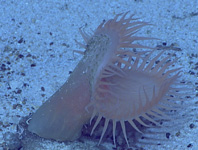Abstract
Two new species of hormathiid actiniarians, Paraphelliactis tangi n. sp. and Phelliactis yapensis n. sp., are described from a seamount near the Yap Trench in the tropical Western Pacific. Paraphelliactis tangi n. sp. has a thick cuticle, a tuberculated column divisible into scapus and scapulus, a complete fifth cycle of mesenteries, an equal number of mesenteries at the margin and at the limbus, and up to 192 tentacles without aboral mesogloeal thickenings that are hexamerously arranged in six cycles. This species differs distinctly from the three known species of Paraphelliactis by the above mentioned features (vs. an incomplete fifth cycle of mesenteries, usually more mesenteries at the margin than at the limbus, and the tentacles with aboral mesogloeal thickenings). So far, it is the only member of the genus Paraphelliactis found in the Western Pacific. Phelliactis yapensis n. sp. has an asymmetric bilobed oral disc and column, tuberculated scapus and scapulus, an incomplete fifth cycle of mesenteries, and up to 162 tentacles with aboral mesogloeal thickenings that are alternately arranged in two cycles. In comparison with other Phelliactis species, the basitrichs of mesenterial filaments of Ph. yapensis are distinctly larger. Phelliactis yapensis n. sp. is the fourth species of Phelliactis found in the Western Pacific.
References
Ammons, A.W. & Daly, M. (2008) Distribution, habitat use and ecology of deep water Anemones (Actiniaria) in the Gulf of Mexico. Deep-Sea Research II., 55, 2657–2666.
http://dx.doi.org/10.1016/j.dsr2.2008.07.015Carlgren, O. (1928a) Ceriantharier, Zoantharier och Actiniarier. Meddelelser om Grønland, Supplement 23, 253–308.
Carlgren, O. (1928b) Actiniaria der Deutschen Tiefsee-Expedition. Wissenschaftliche Ergebnisse der Deutschen Tiefsee-Expedition auf dem Dampfer “Valdivia” 1898-1899, 22, 125–266. [reprint 1–144]
Carlgren, O. (1932) Die Ceriantharien, Zoantharien und Actiniarien des arktischen Gebietes. In: Römer, F., Brauer, A. & Arndt, W. (Eds.), Eine Zusammenstellung der arktischen Tierformen mit besonderer Berücksichtigung des Spitzbergen-Gebietes auf Grund der Ergebnisse der Deutschen Expedition in das Nördliche Eismeer im Jahre 1898. Gustav Fischer, Jena, pp. 255–266.
Carlgren, O. (1934) Ceriantharia, Zoantharia and Actiniaria from the “Michael Sars” North Atlantic Deep-sea Expedition 1910. Report on the Scientific Results of the “Michael Sars” North Atlantic Deep-Sea Expedition 1910, 5 (6), 1–27.
Carlgren, O. (1938) South African Actiniaria and Zoantharia. Kungliga Svenska Vetenskapsakadamiens Handlingar, 17 (3), 1–148.
Carlgren, O. (1941) Papers from Dr. Th. Mortensen’s Pacific Expedition 1914–16. LXX. The Actiniaria and Zoantharia of St. Helena. Videnskabelige Meddelelser fra Dansk Naturhistorisk Forening (Copenhagen), 105, 1–20.
Carlgren, O. (1942) Actiniaria II. Danish Ingolf-Expedition, 5 (12), 1–92.
Carlgren, O. (1949) A survey of the Ptychodactaria, Corallimorpharia, and Actiniaria. Kungliga Svenska Vetenskapsakadamiens Handlingar, 1 (1), 1–121.
Crowther, A.L. (2011) Class Anthozoa Ehrenberg, 1834. In: Zhang, Z.-Q. (Ed.), Animal biodiversity: An outline of higher-level classification and survey of taxonomic richness. Zootaxa, 3148, 19–23.
Doumenc, D. (1975) Actinies bathyales et abyssales de l'océan Atlantique nord Familles des Hormathiidae (genres Paracalliactis et Phelliactis) et des Actinostolidae (genres Actinoscyphia et Sicyonis). Bulletin du Muséum National d'Histoire Naturelle, Paris, 197, 157–204.
Dunn, D.F. (1982) Paraphelliactis pabista, a new species of hormathiid sea anemone from abyssal northeastern Pacific waters (Coelenterata: Actiniaria). Syesis, 15, 51–56.
Eash-Loucks, W.E. & Fautin, D.G. (2012) Taxonomy and distribution of sea anemones (Cnidaria: Actiniaria and Corallimorpharia) from deep water of the northeastern Pacific. Zootaxa, 3375, 1–80.
England, K.W. (1987) Certain Actiniaria (Cnidaria, Anthozoa) from the Red Sea and tropical Indo-Pacific Ocean. Bulletin of the British Museum of Natural History (Zoology), 53 (4), 205–292.
Fangeiro R.M. (2010) Sea anemones (Anthzoa: Actiniaria) fauna of the North Atlantic deep sea. Departamento de Biologia, Universidade de Aveiro, Aveiro, 179 pp.
Fautin, D.G. (2013) Hexacorallians of the World. Available from http://geoportal.ku.edu/hexacoral/anemone2/index.cfm (accessed 7 April 2015)
Fautin, D.G. & Barber, B.R. (1999) Maractis rimicarivora, a new genus and species of sea anemone (Cnidaria: Anthozoa: Actiniaria: Actinostolidae) from an Atlantic hydrothermal vent. Proceedings of the Biological Society of Washington, 112 (3), 624–631.
Hertwig, R. (1882) Report on the Actiniaria dredged by H.M.S. Challenger during the years 1873–1876. Scientific Results of the Voyage of the HMS Challenger, Zoology, 6, 1–136.
http://dx.doi.org/10.5962/bhl.title.11377Humason, G.L. (1967) Animal Tissue Techniques. W.H. Freeman, San Francisco, California, 569 pp.
Mariscal, R.N. (1974) Nematocysts. In: Muscatine, L. & Lenhoff, H.M. (Eds.), Coelenterate Biology. Academic Press, New York, pp. 129–178.
http://dx.doi.org/10.1016/b978-0-12-512150-7.50008-6Molodtsova, T.N, Sanamyan, N.P. & Keller, N.B. (2008) Anthozoa from the northern Mid-Atlantic Ridge and Charlie-Gibbs Fracture Zone. Marine Biology Research, 4, 112–130.
http://dx.doi.org/10.1080/17451000701821744Östman, C. (2000) A guideline to nematocyst nomenclature and classification, and some notes on the systematic value of nematocysts. Scientia Marina, 64, 31–46.
Riemann-Zürneck, K. (1973) Actiniaria des Südwestatlantik I. Hormathiidae. Helgol wiss Meeres, 25, 273–325.
http://dx.doi.org/10.1007/BF01611200Riemann-Zürneck, K. (1986) On some abyssal sea anemones of the North Atlantic (Actiniaria: Hormathiidae). Mitteilungen aus dem Hamburgischen Zoologischen Museum und Institut, 83, 7–29.
Rodríguez, E., Daly, M. & Fautin, D.G. (2007) Actiniaria. In: The phylum Cnidaria: A review of phylogenetic patterns and diversity three hundred years after Linneaeus. Zootaxa, 1668, 131–136.
Rodríguez, E., López-González, P.J. & Gili, J.M. (2007) Biogeography of Antarctic sea anemones (Anthozoa, Actinairia): What do they tell us about the origin of the Antarctic Benthic Fauna? Deep-Sea Research II, 54/16–17, 1876–1904.
http://dx.doi.org/10.1016/j.dsr2.2007.07.013Rodríguez, E. & López-González, P.J. (2013) New records of Antarctic and Sub-Antarctic sea anemones (Cnidaria, Anthozoa, Actiniaria and Corallimorpharia) from the Weddell Sea, Antarctic Peninsula, and Scotia Arc. Zootaxa, 3624 (1), 1–100.
http://dx.doi.org/10.11646/zootaxa.3625.1.1Sanamyan, N.P. & Sanamyan, K.E. (2007) Deep-water Actiniaria from East Pacific hydrothermal vents and cold seeps. Invertebrate Zoology, 4 (1), 83–102.
Simon, J.A. (1892) Ein Beitrag zur Anatomie und Systematik der Hexactinien. Druck von Val. Höfling, Kapellenstrasse 3, München, 102 pp. [pp. 5–106]
Stephenson, T.A. (1918) VII. On certain Actiniaria collected off Ireland by the Irish Fisheries Department, during the years of 1899–1913. Proceedings of the Royal Irish Academy, 34 (B), 106–164.
Stephenson, T.A. (1920) On the Classification of Actiniaria. Part I. Forms with Acontia and Forms with a Mesogloeal Sphincter. Quarterly Journal of Microscopical Science, New Series, 64, 425–574.

